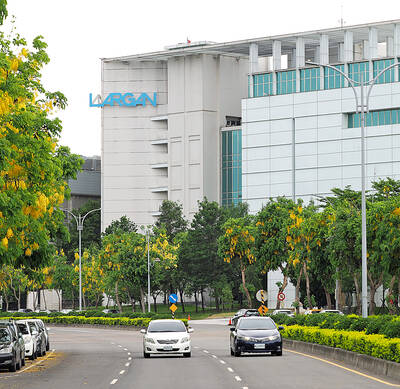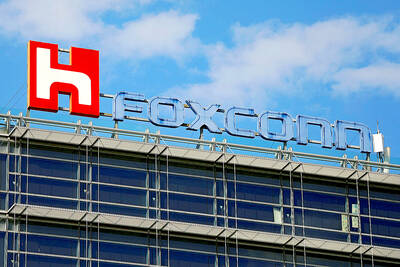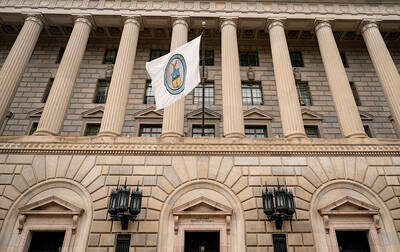Industrial production last month grew 7.34 percent year-on-year, snapping three consecutive months of decline, as strong demand for 5G-related applications and work-from-home and distance-learning trends boosted production of electronic components to a record high, the Ministry of Economic Affairs data showed yesterday.
That growth was supported by a 7.81 percent year-on-year increase in manufacturing production, the ministry said.
The COVID-19 pandemic has stimulated demand for work-from-home equipment such as servers, laptops and communication devices and the demand remains strong, it said.
“It has been a remarkable run for electronic components,” Department of Statistics Deputy Director-General Wang Shu-chuan (王淑娟) told a news conference in Taipei.
Electronic components production increased 23.82 percent year-on-year, marking the seventh month in a row of double-digit percentage growth, according to ministry statistics.
Among the electronic components segment, IC products grew at the fastest-pace of 35.24 percent year-on-year, hitting a record high.
Flat panels and related components continue to benefit from work-from-home trends, with production growing 7.63 percent year-on-year, while electronic and optical products manufacturing expanded 19.4 percent year-on-year.
Automotive and auto parts production declined 19.45 percent annually, which the ministry attributed to collapsing oil prices that restrained consumer demand in the Middle East.
A global drop in demand for vehicles during the pandemic was also a factor, the ministry added.
Petrochemical products also suffered, posting a 22.9 percent year-on-year decline in production, and textiles remain hard-hit, falling 21.46 percent year-on-year, mostly due to decreased or lagging orders in the wake of the pandemic, the ministry said.
Overall, industrial production in the first half of the year expanded at an annual rate of 6.68 percent, while manufacturing expanded 7.17 percent annually, the ministry said.
However, there are signs that the worst is over for some traditional industries, the ministry said.
Machinery equipment production’s decline decelerated to an annual reduction of 5.2 percent, a marked improvement from a 15 percent year-on-year reduction in May.
The decline for chemical materials has also been arrested at 3.1 percent lower year-on-year, according to ministry data.
“We expect traditional industries to ‘warm back up’ as oil and steel prices rise,” Wang said.
The ministry’s survey showed that manufacturing production is to trend up further this month.
Taiwan’s wholesalers, retailers and restaurants are continuing their climb back to normality after being hit hard by COVID-19, the ministry said.
Wholesalers returned to positive territory last month, growing 0.1 percent year-on-year compared with minus-6.5 percent in May.
Retailers declined 1.3 percent, compared with minus-5.7 percent in May, and restaurants declined 7 percent, compared with minus-8.2 percent in May, the ministry said.

Taiwan’s foreign exchange reserves hit a record high at the end of last month, surpassing the US$600 billion mark for the first time, the central bank said yesterday. Last month, the country’s foreign exchange reserves rose US$5.51 billion from a month earlier to reach US$602.94 billion due to an increase in returns from the central bank’s portfolio management, the movement of other foreign currencies in the portfolio against the US dollar and the bank’s efforts to smooth the volatility of the New Taiwan dollar. Department of Foreign Exchange Director-General Eugene Tsai (蔡炯民)said a rate cut cycle launched by the US Federal Reserve

Handset camera lens maker Largan Precision Co (大立光) on Sunday reported a 6.71 percent year-on-year decline in revenue for the third quarter, despite revenue last month hitting the highest level in 11 months. Third-quarter revenue was NT$17.68 billion (US$581.2 million), compared with NT$18.95 billion a year earlier, the company said in a statement. The figure was in line with Yuanta Securities Investment Consulting Co’s (元大投顧) forecast of NT$17.9 billion, but missed the market consensus estimate of NT$18.97 billion. The third-quarter revenue was a 51.44 percent increase from NT$11.67 billion in the second quarter, as the quarter is usually the peak

Nvidia Corp’s major server production partner Hon Hai Precision Industry Co (鴻海精密) reported 10.99 percent year-on-year growth in quarterly sales, signaling healthy demand for artificial intelligence (AI) infrastructure. Revenue totaled NT$2.06 trillion (US$67.72 billion) in the last quarter, in line with analysts’ projections, a company statement said. On a quarterly basis, revenue was up 14.47 percent. Hon Hai’s businesses cover four primary product segments: cloud and networking, smart consumer electronics, computing, and components and other products. Last quarter, “cloud and networking products delivered strong growth, components and other products demonstrated significant growth, while smart consumer electronics and computing products slightly declined,” compared with the

The US government on Wednesday sanctioned more than two dozen companies in China, Turkey and the United Arab Emirates, including offshoots of a US chip firm, accusing the businesses of providing illicit support to Iran’s military or proxies. The US Department of Commerce included two subsidiaries of US-based chip distributor Arrow Electronics Inc (艾睿電子) on its so-called entity list published on the federal register for facilitating purchases by Iran’s proxies of US tech. Arrow spokesman John Hourigan said that the subsidiaries have been operating in full compliance with US export control regulations and his company is discussing with the US Bureau of